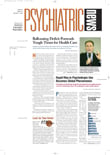Health care policy analysts who met last month expressed gratitude for only one aspect of the election—they weren't still in suspense about the outcome.
At the Grantmakers in Health (GIH) Fall Forum, Robert Reischauer, president of the Urban Institute, described a bleak context for a subsequent panel discussion titled “The 2004 Election: What Do the Results Mean for Health and Health Care?”
GIH is a nonprofit organization that educates grant-making entities such as foundations about the relevance of public policy to their work and raises awareness among policymakers about health philanthropy.
Reischauer began by charging that in terms of health care, “neither [candidate] was willing to confront the fiscal constraints that are going to face the next president and policymakers at the state and local levels.”
He added that the disconnect is most acute in the area of health care, where “almost all of the solutions to pressing problems cost huge amounts of money.”
Reischauer offered attendees an encapsulated version of “how we got into the current predicament that we're in” in terms of financial constraints.
In January 2001, the federal budget showed a surplus of $236 billion. By 2004, the federal budget deficit was $413 billion, a record for the country.
Among the factors contributing to the change were federal tax cuts, the economic “downturn,” and increased spending on defense.
Reischauer then offered a glimmer of good news before adding new details to his discouraging portrait of the future.
He said that the seriousness of a deficit should be considered in relation to the size of the overall economy. Although when measured in dollars, the current deficit is the largest in history, deficits in the early 1990s were larger in proportion to the gross domestic product.
Addressing the current deficit, however, will be particularly difficult because the retirement of the baby-boom generation is “staring us in the face.” They will begin to collect Social Security and Medicare benefits and likely will also form a powerful voting block that complicates the prospects of change to those programs.
What do budget deficits have to do with the prospects for health care reform? “The simple answer to that [question] is `a great deal,'” said Reischauer.
He pointed out that the country's willingness to address such problems as the growing number of uninsured and prescription-drug insurance coverage will be constrained by fiscal problems.
In addition, health programs already account for about 25 percent of the federal budget, and their budgetary significance is expected to grow.
Projected growth in Medicare assumes seven annual cuts of 5 percent in physician payments starting in 2006, an event that Reischauer said “will not happen.”
Reischauer concluded by saying that “the collision between health policy and fiscal constraints is likely to be most evident in the area of new priorities.”
Jackie Judd, vice president of the Kaiser Foundation and moderator of the subsequent panel, opened by saying, “Health care never really made it into the first tier of issues voters said they were interested in.”
Peter Harkness, editor and publisher of Governing magazine, agreed, saying that health care was “way down the list.”
Thomas Mann, senior fellow at the Brookings Institution, told the audience that President George W. Bush claims a mandate for his view that social insurance programs, such as Medicare, should be transformed to make individuals more responsible for their retirement and health insurance.
Rebecca Adams, a reporter for Congressional Quarterly, listed medical malpractice reform, health care tax credits, and conversion of Medicaid into a block-grant program as initiatives Bush would likely push. She added that the increasing cost of long-term care is a major problem for Medicaid, but likely would not be addressed.
Harkness said that increasingly health policy is not being made at the federal level and is “sent down” to the states as much as it is made at the state level and sent up.
California, for example, passed ballot initiatives supporting the development of stem-cell research and providing increased funding for mental health. Minnesota initiated the first state-sponsored Internet site that enables residents to purchase drugs from Canada. Both states have Republican governors, Harkness noted.
Transcripts of “Setting the Context” and “The 2004 Election: What Do the Results Mean for Health and Health Care?,” are posted at<www.kaisernetwork.org/health_cast/hcast_index.cfm?display=detail&hc=1303>.▪
